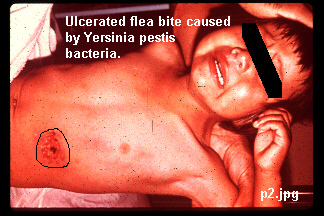|
Yersinia
pestis bacteria has an incubation period of 2 to 8 days. The
victim experiences a fever in the range of 103°F-106°F, a quickening of
pulse and a decrease in blood pressure. Other possible symptoms
are convulsions, vomiting, intolerance to light, delirium, and pain in
the limbs. After the initial symptoms, the bacteria finds the
nearest lymph node, which soon becomes swollen and painful and sometimes
dark in color. They are the size of an egg or a small apple.
This is what is known as the infamous bubo. Technically this is
the multiplication of Y. pestis in one area and can be extremely
sensitive. Sometimes Petechiae (small, red spots) also appear.
There are additional effects for the different kinds of plague.

Photo: Centers for Disease Control and Prevention
Without the right
medical treatment, half of people suffering from Bubonic plague die, and
all cases of Septicemic and Pneumonic plagues result in death.
"It was a
plague that touched people of every condition, age, and sex. They
began to spit blood and then they died-some immediately, some in two or
three days, and some in a longer time. And it happened that
whoever cared for the sick caught the disease from them, or infected by
the corrupt air, became rapidly ill and died in the same way. Most
had swellings in the groin and many had them in the left and right
armpits and in other places; one could almost always find an unusual
swelling somewhere on the victim's body."
-Matteo Villani,
Florentine chronicler |